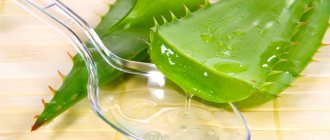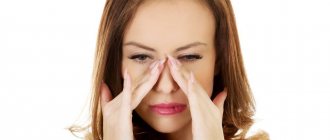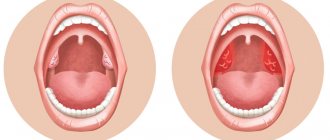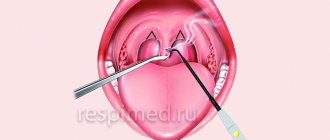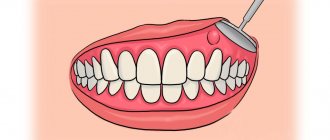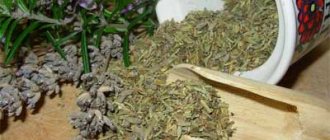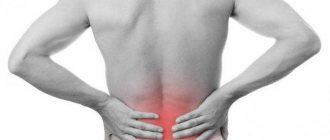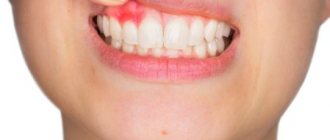Exfoliative cheilitis is an inflammation of the lips, and only the border of the lips is affected, becoming bright red, painful and irritated. To date, there is no consensus regarding the origin of the disease. Most researchers tend to believe that the cause of its occurrence is a combination of neurogenic factors. According to statistics, the majority of patients diagnosed with exfoliative cheilitis are women between twenty and forty years old.
Many patients suffering from exfoliative cheilitis have a history of psycho-emotional disorders. A significant percentage of cases are associated with depressive states, neuroses and autonomic dysfunctions. Among the provoking factors there are also immunological, endocrine and hereditary predisposition factors.
The disease has no tendency to remission or self-healing, assumes a long course and can transform over time from one form to another.
What it is
Chronic damage to the red border of the lips, in which peeling and irritation does not spread to the surrounding tissues, is called exfoliative cheilitis. Women of childbearing age are most susceptible to this disease.
Doctors distinguish two forms of exfoliative cheilitis:
- The dry form is accompanied by chronic dry lips, peeling, and sometimes itching and burning. Often, hyperemia begins between the mucous and red border, resulting in the formation of a dense strip consisting of transparent scales at this border. When this layer is surgically removed, the unprotected surface of the rich red mucosa is exposed. Most often it is smooth to the touch, but it may develop shallow ulcerations or bumps.
- The exudative form differs from the dry form by sharply enlarged, swollen, hyperemic lips. The patient cannot close his mouth completely due to pain, as a result of which his lips are constantly parted. This form of exfoliative cheilitis got its name due to the constant release of exudate, which gradually dries out and forms massive crusts. In most cases, they are quite easy to remove, but sometimes the exudate and scales can grow together, forming a continuous layer hanging down to the chin.
Not all patients believe that the dry form requires treatment in the same way as the exudative one, as a result of which the disease quickly becomes chronic and can last for many years. In addition, both forms of the disease can transform into one another, but very rarely spontaneous recovery occurs. Some people mistakenly consider this type of disease to be precancerous.
Symptomatic cheilitis in children
Hypovitaminous cheilitis is manifested by cracks on the lips. The disease develops due to a deficiency of retinol and B vitamins. Cracks can occur as a result of non-compliance with general hygiene rules, the habit of licking or biting lips. Treatment: use of mucosal epithelium reparants - carotolin, rosehip oil, retinol.
Eczematous cheilitis is a symptom of a general eczematous process in which the surface layers of the skin become inflamed. Its treatment involves the use of steroid ointments. As soon as the condition improves, the doctor may recommend ointments such as naphthalan, sulfur-tar or boron-tar.
Macrocheilitis is manifested by cracks, pallor, swelling of the lips, and the appearance of scales. Treatment is carried out using hyposensitizing drugs, hormones, antibiotics, ointments with heparin and dimexide.
Atopic cheilitis is accompanied by swelling, itching, peeling, swelling, and erythema. After some time, crusts form. Treatment - antibacterial and antihistamines, anti-inflammatory drugs, ointments with corticosteroids, vitamins. It is necessary to limit carbohydrates and avoid spicy foods.
Causes
According to research results, the main cause of the development of exfoliative cheilitis is a disruption of the central nervous system, accompanied by depression, nervous exhaustion, apathy, phobias and other psychosomatic reactions. In addition, some doctors share the view that genetic abnormalities and systemic allergic reactions are involved in the development of this disease. The possibility of a sharp decrease in immunity cannot be ruled out.
In some patients, this type of cheilitis occurs due to problems with the thyroid gland. Another suspected reason is an increase in the permeability of capillary walls. However, the pathogenesis and etiology of exfoliative cheilitis are still not fully understood.
Material and methods
100 children aged 3 to 15 years (54 girls and 46 boys) suffering from food intolerance to cow's milk proteins and 30 children from a comparison group who did not suffer from allergic diseases were examined. Most of the children in the main group (80 people) were treated as inpatients in the allergy department of the Federal State Institution Moscow Research Institute of Pediatrics and Pediatric Surgery of Rosmedtekhnologii. The remaining 20 children were treated at the clinic of the Department of Pediatric Therapeutic Dentistry of the Center for Dentistry and Maxillofacial Surgery of the Moscow State Medical University. The diagnosis of the underlying disease in children undergoing hospital treatment was made by an allergist on the basis of an in-depth clinical and laboratory examination.
Skin lesions are the earliest visual symptom of allergic (including atopic) reactions in children. In the first 3–5 months of life, signs of skin lesions were noted in 56 children. By one year, in 44 children, skin manifestations were regarded as an acute process. At the same time, in 39 children, the pathological process on the skin was characterized by hyperemia and weeping.
In the main part (75 people) of the children we examined, the first symptoms of skin lesions appeared when the child was transferred to artificial or mixed nutrition (supplementary feeding with formula milk or whole cow's milk). Another reason for the appearance of inflammatory reactions on the skin in some children (n = 20) was the consumption of highly allergenic foods by mothers (chocolate, citrus fruits, coffee, cocoa).
Early transfer of children to artificial feeding and consumption of obligate allergens by mothers contributed to the formation of both the underlying disease and intestinal dysfunctions, consequently, increasing the antigenic load on the body and its sensitization.
According to the anamnesis, in 20 patients, after an acute skin process in early childhood and the subsequent long-term remission, the atopic process took a chronic course, localized in the perioral area, which was not accompanied by damage to the skin of the elbow and popliteal folds, ankle and wrist joints. The so-called isolated AH. In the remaining 80 children of the main group, AC developed against the background of the underlying disease - before, after or simultaneously with damage to the skin of the joint flexures.
Thus, a detailed analysis of anamnesis data made it possible to establish that AC can form against the background of typical clinical manifestations of dermatosis or as an isolated chronic lesion of the perioral area after the acute phase of AD.
The complaints of children with isolated AC and AC with AD were similar. However, in the isolated variant of AC, complaints of perioral itching were presented somewhat less frequently, which, in our opinion, is explained by less damage to the perioral skin of this category of patients.
Fine-plate peeling with whitish flakes of the skin of the corners of the mouth occurred in both forms of AC and was observed significantly more often than peeling with large scales. In case of isolated AC, small-plate peeling predominated in the area of the outer part of the KKG, while in case of cheilitis against the background of AD, peeling of small and large scales was equally common in this part of the lips.
The absence of a clear border between the skin and the CCG along its entire length was less typical for isolated AC, which indicates a greater involvement of the skin of the lips in the pathological process during cheilitis against the background of AD.
Cracks in the corners of the mouth and in the area of the outer part of the coronary artery were somewhat more often observed in children with AC against the background of AD. In the corners of the mouth, in the area of the outer part of the KKG and in the Klein zone, both deep single cracks and multiple microcracks were found. Thus, with isolated AC, fine-plate peeling on the perioral skin and exfoliative scales in the area of closing the lips are somewhat more often observed, and with cheilitis against the background of AD, more pronounced peeling of the lips, swelling of the CCG and mucous membrane are found in the absence of a clear boundary between the CCG and the skin.
Treatment regimen for AC in children with allergies to cow's milk proteins
Based on scientific research conducted to study the main aspects of the pathogenesis of AC, algorithms for its treatment have been developed and have been used for many years. An integral part of the complex treatment of AC in the children we observed was external therapy. The dosage forms used (pastes, creams, ointments) had not only a local, but also a general effect on the body through the neuroreceptor apparatus as a result of skin absorption. The disappearance or reduction of skin rashes or subjective sensations such as itching, pain, burning had a beneficial effect on the general and psycho-emotional state of children.
Ointments were prescribed externally to the lips of children suffering from AC: 0.05% alklometasone and 0.1% methylprednisolone aceponate; For dry facial skin, 1% pimecrolimus cream was used. The preparations were applied in a thin layer to the affected surface 2 times a day and gently rubbed in until completely absorbed.
Ointments were used until symptoms disappeared completely. For children suffering from AC complicated by streptostaphylococcal infection, crusts, scales and dry CCG were softened using proteolytic enzymes. To do this, a gauze pad moistened with a 0.1% solution of trypsin or chymotrypsin was applied to the CCG and the skin of the perioral area. The enzyme exposure was 10–15 minutes. Ointments were prescribed: 0.05% alklometasone and 2% fusidic acid in equal parts. The drugs were applied to the affected areas of the skin 3 times a day for 10 days.
Symptoms
The main signs of exfoliative cheilitis are dryness, flaking and itching that do not extend beyond the red line of the lips. The mucous membrane of the oral cavity, the corners of the lips and the skin around them are not affected. The main manifestation of the dry form is the formation of scales, which the patient most often simply bites off, not attaching importance to the disease and without consulting a doctor. After removing the scales, a red, hyperemic surface remains, on which scales form again within a week.
In the exudative form, the symptoms are characterized by the presence of pain, the formation of gray and brownish crusts of scales and dried exudate, which complicate eating and communication.
How the problem manifests itself
HC “announces itself” with classic symptoms - characteristic red dots appear on the border of the lips (seen in the photo above). These are nothing more than the mouths of the salivary glands affected by the disease. If you blot your lips, after a short period of time droplets of secretion will appear on them again. Due to the fact that saliva is produced in excess of normal, the surface of the lips is constantly moisturized. But due to the constant evaporation of liquid, the skin, accustomed to “humidity,” cracks and flakes.
Secondary GC is a complication of skin diseases, pathological processes in the oral cavity, the result of smoking and neglect of the rules of caring for teeth and gums
In some patients, the course of HC is associated with constant itching in the affected area. At the same time, the “affected” skin looks rough, unhealthy, the epithelium becomes keratinized and dry. White ring-shaped formations often appear around the mouths of the salivary glands - these are foci of leukoplakia. The purulent form of cheilitis most typically manifests itself. Thus, the lips swell, become extremely sensitive to any mechanical damage, and are very painful.
On examination, the skin looks red, swollen, thinned, flaky, the epithelium is covered with multiple purulent crusts. Upon palpation, enlarged, compacted salivary glands are determined, when pressed, a secretion mixed with purulent exudate is released. In the complicated course of Volkmann's cheilitis, local signs of inflammation are accompanied by symptoms of general intoxication of the body, enlargement of the submandibular lymph nodes, and abscess formation of the lips.
Diagnostics
To make a correct diagnosis, the doctor must be able to distinguish the manifestations of exfoliative cheilitis from other types (eczematous, actinic, contact, atopic), as well as from the symptomatic picture of lupus erythematosus. Unlike all of the listed diseases, this type of lesion is not accompanied by the formation of blisters, erosions, cracks, scars and other lesions, with the exception of those listed above, and does not spread beyond a certain part of the red border of the lips. The transition of this type of cheilitis to others is also not noted; only an internal transition from one form to another is possible.
Treatment
If you are diagnosed with exfoliative cheilitis, treatment should be comprehensive. The prescription of drugs will depend directly on the probable cause of the disease. The psycho-emotional cause involves treatment with antipsychotics, antidepressants and even tranquilizers. In addition, the patient needs to seek professional help from a neuropsychiatrist.
To eliminate scales, crusts and itching, it is recommended to constantly lubricate your lips with oil solutions, creams or hygienic lipstick. If you have other symptoms (dizziness, lump in the throat, shaking hands, dry mouth), it is recommended to get tested for thyroid hormones and begin appropriate treatment.
Among other things, immunocorrection and the use of vitamin-mineral complexes would be useful. In difficult cases, the doctor may prescribe local administration of hormonal drugs through ultrasound or laser therapy. With long-term treatment, the exudative form can turn into dry.
Prevention
Since it is impossible to predict the development of exfoliative cheilitis, the only means of prevention will be oral hygiene, proper nutrition, a healthy lifestyle, giving up bad habits and taking a course of vitamins in the autumn-winter period. It is necessary to carefully monitor the immune system and take timely measures to restore it. Also, do not overuse lipsticks containing lanolin, as it clogs pores, dries out lips and often causes an allergic reaction.
